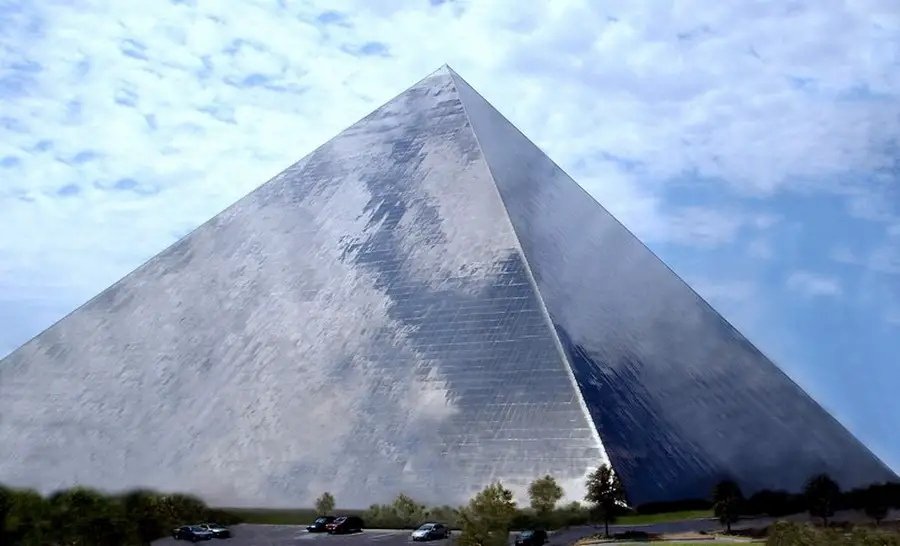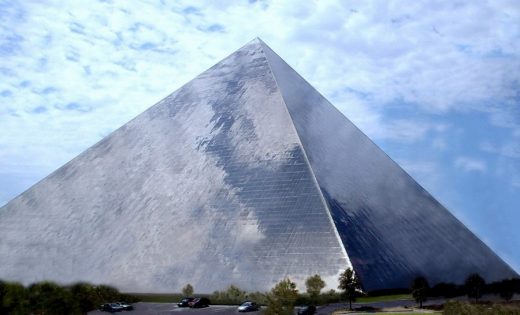Large Span Translucent Building Design, Eco Sustainable Structures, Architects
Large Span Translucent Building : Eco Sustainable Architecture
Global Ecological Development – article by S. P. Alekseev, 3 Mar 2013
3 Mar 2013
Sustainable Architecture of the Future
Article by Sergey P. Alekseev, Structural Engineer, Russia
Large Span Translucent Buildings
Abstract:
This paper considers an issue of eco-sustainable architecture development. It reviews an opportunity of constructing a new type of large-span translucent buildings and structures, capable of not only expanding significantly the reach of comfortable and safe human environment but also improving liveability of our cities.
A discussion is open regarding the features and properties of the new architecture that, in the authors opinion, will soon make our cities more environmentally friendly, rendering greater energy efficiency and general attractiveness.
S. P. Alekseev
Large Span Translucent Buildings
Eco Sustainable Architecture of the Future: Large-Span Translucent Buildings and Structures
A 200 m-high translucent pyramid structure:
At all times, people have strived to achieve safety and protection against a great number of unfavorable impacts and threats of the environment. Heat and cold, rain and wind, predators and savages, have always posed challenges to the peaceful life of man. From the earliest times, people have built shelters, thus creating an artificial habitat protecting them from the aggressive world outside, which added in the comfort and security desired.
Thus, architecture, from its origin through all its history, has served as a magnificent instrument for the creative efforts of man, utilizing the technology available and enjoying the aesthetic views existing in the society to respond to these vital needs of human life.
Now has come a wondrous epoch of construction technology! Now is the time that nearly any of conceivable and most daring fantasies of architectural mind can be realized. Today, a modern architect implementing a complicated project tends to be often limited by mere considerations of utility, public demands, and time and financial constraints, rather than by a lack of technologies available for a large-scale project of structural complexity. Furthermore, the principles of booming sustainable development and green building are giving rise to eco-friendly sustainable designs.
However, having taken a good look at some architectural masterpieces of contemporary design, one cannot help pondering whether architecture today is losing much in fulfilling its true purpose. It is depressing to see that a lack of fresh ideas make some modern architects be lost in the hunting after decorative showiness, pandering to their clients bad tastes.
Problematic as it may be, the modern society today is apt to resort to architectural knowledge to reach a far more important strategic objective, namely, revision of the living space structure in modern megalopolises. Affected by their past, the urban complexes have gradually developed into a complicated knot of problems that call for solution in order to provide tranquility and security for the well-being of their inhabitants.
This paper is to consider a real opportunity for contemporary architecture to transit onto a new stage of its development. In this consideration, an effort is undertaken to explore how not only can architecture expand maximally the reach of comfortable and safe human environment but also gradually change the appearance of our cities and improve their liveability, creating new green buildings and sustainable structures safely sheltered from many of the environmental threats. Hopefully, having been acquired over long history, all the positive trends and reasonable principles of architectural science and culture will also stay in demand.
From the second half of the 20th century on, construction science in the USSR, USA and other countries has endeavored to develop translucent dome structures protecting urban areas from unfavorable weather conditions, negative local climate patterns, excessive solar radiation, and other adverse impacts of the environment. Over recent years, the list of factors affecting liveability of cities and thus stimulating research in this field has extended to also include increased environmental pollution, escalating threats of extremism, and the necessity for urban population to minimize required inputs of energy.
Global climate changes are growing so unpredictably and at such threatening rate that it would only seem wise not to wait for the critical outbreak of natural calamities but rather take more active steps in developing the construction technologies of translucent protection structures and gain experience in this type of construction. (This appears to be a more preferable course of action in contrast to the persistent practice of digging underground shelters, which seem to have spread globally over recent years yet having little chances of ever being used as intended. )
Khan Shatyr Entertainment Center in the city of Astana, Kazakhstan:
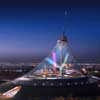
image : Foster + Partners
As of today, the development of large-span translucent protection structures (further, LSTP structures or LSTPS), which offer plenty of daylight and comfort, still generates new ideas and creates unique projects (such as the Dome over Houston – http: //youtu. be/vJxJWSmRHyE ); and some of such audacious projects have now been implemented.
One of such projects is sited in the city of Astana, where a multinational team from Kazakhstan, Turkey and Great Britain erected a giant 100 m-high (if measured without the spire) transparent tent of the Khan Shatyr Entertainment Center. Khazakhs take much pride in it and made a documentary film titled The Worlds Greatest Tent featuring this wondrous project ( http: //youtu. be/W3PfL2WY5LM ).
In Germany, even a more fascinating and ambitious project has been created, offering an artificial Tropical Islands park enclosed in a 5.5 million cubic meter space, which reputedly makes it the worlds largest indoor translucent structure. (Tropical Islands – https: //www. youtube. com/watch? v=B_tRPBLa6K8&list=UUScOM_BobA1zD8qGbOA-Qig&index=4&feature=plcp ).
Tropical Islands park in Germany:
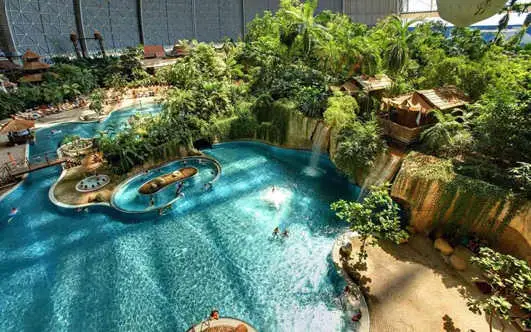
image from S. P. Alekseev
In 2012, a patent [1] was granted to a group of Russian structural engineers in the development of a feasible, relatively simple, cost-effective and quite instrumental concept that can be useful for construction of such projects. The concept involves constructing a reliable cable-supported multilayer translucent roof enclosing large and superdimensioned spans between buildings thus integrating the buildings into a whole complex, to build a strong translucent protecting shell.
The translucent shell allows maintaining at a stable and comfortable level the internal climate parameters: temperature, humidity and clarity of the air, the lever of illumination, security parameters, etc.
The idea of multilayer cable-supported systems stems from the known structures of cable roofs, which have over half a century been used widely in the construction of large-span structures. Thus, as early as 1967, in Saint-Petersburg (then named Leningrad) a similar technology was utilized to build the ‘Yubileyny Sports Palace’; the sports complex has since been in active use and is still used today. Another example is a most up-to-date athletic complex ‘Minsk Arena’ unveiled in Belarus in 2009.
The LSTPS layouts and construction technology (exemplified in Fig. 1 displaying a 200 m-high glazed pyramid) are basically the same as those for the sports complexes mentioned above. It is obvious for those skilled in the art that the distinctions between the design of such pyramid and the examples of the sports complexes are basically as follows:
1. Unlike the support contour of the athletic arena exterior walls, the pyramids support contour comprises buildings embedded into the soil.
2. The cable roof has a central metal ring with prestressed high-tensile steel cables attached to it; the central metal ring is not suspended over the arena; rather, it is freely positioned on the highest support of the protection structure.
3. The roof presents a three-dimensional multilayer cable-supported structure rather than consists of two-layer cable trusses; in the exterior view, the cable-supported three or four-layer LSTPS shell resembles a steel web, many layers of which are stretched over the buildings.
By and large, only the visual aspects of the proposed translucent structures are different; the essence of the roof structure remains very much the same as that of the Minsk Arena and Yubileyny Sports Palace.
Essential features and competitive advantages of large-span structures having multilayer cable-supported shells
Instead of supporting structures specially designed, LSTPS complex basic buildings prepared to serve for supports to the large-span multilayer cable shells allow the ineffective spending on shell construction to be maximally reduced, at the same time, improving the total structural safety.
Structures supporting multilayer cable roofs vary in height, preferably, with taller structures located in the center of LSTPS complex and gradually decreasing in height towards the periphery of support contour; that makes it possible not only to improve the basic performances of load-carrying cable systems but also to provide the required outward slope of the translucent shell.
The multilayer arrangement of cable-supported systems makes them biconvex in shape over spans of any size and allows any possibility of positive deflection to be avoided under a specified total load; moreover, all the loads (including point loads) acting on the cable roof are rationally and reliably distributed in the three-dimensional multilayer cable system; and, if not all, then at least a very significant part of the load-carrying cables resist the load.
The three-dimensional translucent shell contains multilayer cable systems that comprise high-tensile prestressed cables made of steel wires and/or carbon fibers; and installed over the cables is a rigid frame structure carrying translucent components. Such roof structure not only imparts additional rigidity to the cable systems but also provides reliability and integrity of the translucent shell in case of emergency failure of some cables in the roof systems.
A great load-carrying capacity of the multilayer cable systems along with their durability and rigidity offer a free choice of any translucent materials to be used for translucent components and make it possible to equip the cable roof with all the instruments and systems required for its stable operation; it is important that heat, optical, strength and other properties of translucent materials must be selected to comply with the weather conditions, where LSTP structures are to be used.
LSTPS systems can be made of the shape and size desired, depending on the combination of features and mutual alignment of the cable and supporting structures.
Already today, such reasonably sized translucent structures (for example, a 200 250 m-high glazed pyramid illustrated in Fig. 1) could relatively easily be constructed to implement the proposed multilayer cable-supported roof systems, with a qualified intake of the best specialized construction companies (such as, for example, Freyssinet International & Cie, France, or Tokyo Rope Manufacturing Co., Ltd., Japan).
It should be noted that the technology of cable-supported multilayer translucent systems enclosing large and superdimensioned spans between buildings makes it possible to construct buildings and structures of various shape, capacity and purpose: hangars, production shops, and atrium spaces of enormous proportions; shell-covered athletic arenas and football stadiums; translucent roof-covered residential areas; glazed pyramids of up to 500 meters in height, accommodating highly engineered multipurpose facilities; large-span suspension bridges of an advanced design, etc.
There are clear advantages of translucent multilayer cable-supported shell systems over traditional technologies: the high strength and great durability, the excellent load-carrying capacity, the usability of lightweight structures, the feasibility to span considerably greater areas, the improved roof transparency, the many-fold reduction in the quantity of metals required for construction, and, consequently, the relatively low costs.
In addition, multilayer cable-supported roofs for large-span structures, even when constructed in the earthquake-prone regions, would not entail increased danger for people, since the probability that the roofs collapse can practically be ruled out, provided that certain reasonable engineering solutions are introduced. On the contrary, owing to their excellent strength properties and as a result of mutual alignment and interworking with the supports, the proposed cable-supported systems can provide improved stability of high-rise buildings integrated with the translucent protection structures.
Vast expanses of LSTPS atria can be diversely arranged. For example, such atria (which can expand over millions of cubic meters) can easily contain a most magnificent water park, a full-scale sports stadium, and many other facilities. Most evidently, the majority of translucent structural projects will eagerly make use of the favorable opportunity to lay out large and enjoyable landscaped gardens: indeed, in such greenery planting areas, residents and guests will have the rare treat of enjoying nature all the year round, regardless of the rainy days in fall or the snow and cold of winter on the outside.
The environmentalists should bear in mind that LSTPS construction involves activation of a crucially important process of interpenetration. On the one hand, similarly to any conventional construction project, constructing translucent structures will penetrate into natural environment, inevitably conquering and destroying the harmony-filled spaces of nature; on the other hand, however, nature itself will penetrate the vast man-made interiors of translucent structures.
Naturally, taking up the specially designed spaces and forming sustainable ecosystems (actively fostered by man), nature will be able to fill future architectural sites thus adding in their functional and attractive qualities. The best man-made LSTPS sites will, without a doubt, become the occurrences of mutualism, beneficial to both nature and man involved.
LSTP structures are envisioned to be constructed in the direction of residential quarter development. Initially, as one of the optimal examples of such functional development can be a regular tetragonal pyramid (Fig. 1) having the following parameters:
Height is 200 m;
Base dimensions are 300 300 m;
Area of the base (the translucent roof-protected area) is 9 ha;
Envelope area is 150,000 m2 ;
Enclosed volume of the pyramid (P200) is 6.0 million cubic meters (which is greater than any translucent building man has ever built).
In such a glazed roof-protected residential block, it would seem reasonable to have only 320 – 450 thousand square meters of the usable area taken for commercial and residential buildings, which would substantially occupy the basic buildings supporting the translucent structure; the rest of the space would be designed for multifunctional atria.
For comparison, if an ideal pyramid P200 (3:4:5) were made only 50 meters greater in height, then an ideal pyramid P250 would have the following parameters: 250 m in height, 375 x 375 m in the base dimensions, Sbase = 14.1 ha, Senvelope = 235,000 m2; and, which is especially fascinating, the enclosed volume of such translucent structure would be nearly doubled to amount to 11.7 million cubic meters; and the area taken for commercial buildings will be as great as one million square meters.
Atria spaces in the Gaylord Hotels in the United States of America:
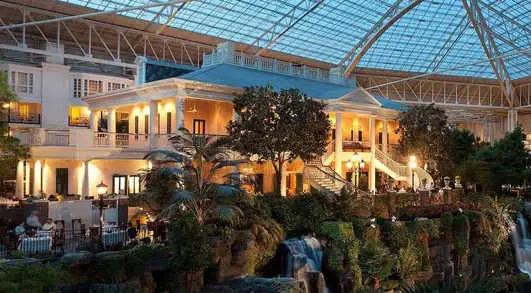
image from S. P. Alekseev
LSTPS main benefits and results expected from the project
Obviously, there are plenty of them: attractive economical feasibility and eco-friendliness of the project; sustainable development of the artificial environment intertwined with natural surroundings and improvement in the quality of human life; ecological advancement of the existing megalopolises and formation of a new type of eco-cities; feasibility of constructing LSTP structures in various climatic regions; and new technology advances.
All in all, the principal result expected from the construction of eco-sustainable large-span translucent structures is an improved comfortable human environment of greater reach without harmful impacts on nature.
1. LSTPS construction can be justified not only as a means for protecting people, buildings and adjacent territories (enclosed in the interior of such structures) from many of the negative external effects, but also as being extremely attractive in terms of economical feasibility and efficiency.
The costs spent on translucent roof construction would not exceed 4 5 % of the whole LSTPS complex construction budget; and, at the same time, the envelope of translucent structure provides at least a 20% reduction in surface area relative to the total envelope area of the whole complex of buildings inside. [2]
Naturally, the larger is the LSTPS complex volume, the greater is the improvement of the parameters, i.e., the portion of protection roof costs in the whole LSTPS construction budget will be less, and the economic effect resulted from the use of translucent structure will increase, owing to the favorable change in the area ratio for envelope structures and as a result of the improvement in other parameters discussed below.
It means that the construction costs of a complex of buildings (for instance, a residential block) would approach the costs of the same complex of buildings but covered with a translucent roof.
At the same time, those skilled in the art should understand that all wind loads acting on such structure will be accepted by the translucent cable-supported roof and only the vertical components of wind loads are to be transferred onto the high-rise support buildings of the interior (so long as the horizontal components of the wind loads are accepted by the support contour of the roof structure).
Considering this favorable circumstance, an LSTPS project can substantially cut expenses on high-priced design solutions to provide the rigidity and stability required for the supporting high-rise buildings. At the same time, further reduction in the construction costs will be possible due to reasonable saving on the thermal insulation and weight of the envelope structures of the LSTPS buildings supports, their cost-efficient external finish and other similar nuances.
Undoubtedly, all such cost-cutting measures will in the long run optimize LSTPS construction in such a way that it will be far cheaper to construct a translucent roof-covered complex of buildings than to construct such complex without the protection roof. Positive economic effect resulted from the use of LSTPS construction will be achieved through the optimization of a great number of LSTPS economic parameters and performance indicators as well as via considerable cut in the direct operating costs. For similar projects yet constructed in different climatic conditions, the economic effect will be especially pronounced in winter time for cold climate regions, and in summer time for warm climate regions.
What is most important is that LSTP structures will be able to provide all-the-year-round comfort and security of the occupants both inside the buildings and in the surrounding spaces of atria.
2. The greater is the LSTPS interior volume, the more feasible it is to create a stable and balanced system of crucial structural elements and to maintain the performance parameters ensuring comfortable and secure surroundings of human activity. Engineering systems (for example, HVAC air recovery systems, etc.) are known to be considerably more efficient in large premises, because they are less expensive to make and are more efficient in operation (in terms of space efficiency measured per square meter of usable area).
An extensive LSTPS roof area makes it possible to collect rainwater for non-drinking water purposes, which will drastically reduce potable water consumption. A large difference in height between the levels in a large translucent structure will efficiently ventilate the LSTPS interior, bringing in a natural draft effect which draws air through the structure.
Moreover, the warm air will create a buoyancy effect (following the Archimedes principle), which will, to some extent, reduce weight loads on the bases of supporting buildings. It is also important that being inside large spaces of atria (which can enclose over one million cubic meters), the occupants will not feel discomfort caused by small rooms.
3. When built in warm climate conditions, the LSTPS translucent roof elements can be partially replaced by solar batteries, which not only can provide required energy inputs but can also create shaded spaces, saving considerable energy supplies needed for air conditioning. In this case, resorting to special shading devices, light-reflectors, refractors, and other instruments and equipment installed on the translucent roof, a comfortable environment inside LSTP structures can be created with the use of the automatic control of solar energy penetrating the translucent structure.
With the translucent roof installed at a certain height over the ground, the roof and the equipment will be nearly invisible for the occupants of the structure, owing to such light phenomena as reflection, refraction, diffraction, and interference.
4. In the regions of the Extreme North and Siberia, LSTP structures can provide people (most importantly, children) with shelters of year-round use, protecting them from extremely low temperatures in winter and blood-sucking insects in summer. To provide protection against snowdrifts, special simply-designed snow-removal devices have been made along with now widely-used de-icing systems.
LSTPS construction offers great energy efficiency opportunities that include the so-called low-potential heat sources, the measures to prevent uncontrolled heat loss through the translucent structure and to exclude unsupervised actions of people adversely affecting its heat efficiency.
Realizing the LSTPS concept in the regions of the Extreme North and Siberia will help transform our cities into lush greenery oases of comfortable climate, blooming inside despite the storms and frosts outside, thus forming an attractive model for the territorial development of otherwise unpopulated regions in the severe climate conditions. Translucent multilayer cable roof systems can be successfully used for covering sports stadiums, which will only benefit from this; moreover, the translucent roofs can be made retractable.
5. Sick and tired of gas-guzzling cars, the LSTPS occupants will only welcome a car-free space, where transportation can be provided by environmentally-friendly vehicles, such as mini electric cars, bicycles, high-speed walkways, travelators, incline elevators, and other indoor transportation systems.
Conventional environment-unfriendly vehicles for outdoor transportation will be parked in carports and parking lots, preferably, underground in the LSTPS support contour buildings; this will improve the environmental conditions of courtyard space. The LSTPS atria will certainly impart appeal and enjoyment to our backyards and courts, transforming them into a social space of many attractions.
Today, the public spaces adjacent to residential apartment buildings are mostly dilapidated, filthy, and crammed with cars, which makes them neither favorable for friendly talks with neighbors, nor suitable as a playground for children, nor enjoyable for outdoor sporting activities. It is therefore not surprising that most of the residents prefer spending their free time away from the inhospitable areas of their courtyards.
6. A growing demand for LSTP structures will inevitably result in motivated advancement of the construction-related science in the direction of: advanced materials and technologies; energy efficient structures providing full independence from outside energy supplies; realization of high-technology devices capable of fully automated control and maintenance of all LSTPS engineering systems, depending on external and internal conditions; which will integrally constitute the architectural structures being rightfully called intelligent buildings.
7. Supported with the development of weather control technologies, it will be not impossible in future to artificially create in the LSTPS interior the favorable weather conditions: directed temperature fluctuations during the day, desirable illumination modes, breeze-simulating air conditions, artificial rains according to a schedule, fragrances and natural sounds of any choice, etc.
8. LSTPS construction, by many criteria, optimally fits the mold of a green building approach and will promote not only the quality enhancement of construction projects but also the best support of environmental protection. LSTPS construction will help to achieve the following important goals of the sustainable development and green standard requirements (e.g., LEED, BREEAM, DGWB):
To reduce consumption of energy and non-renewable materials and resources;
To minimize unfavorable impacts on natural ecosystems;
To ensure a comfortable human environment;
To produce new energy-efficient and environmentally-preferable products, creating new jobs in industry and maintenance sectors; and
To shape social needs for acquiring new knowledge and creating new technologies in the field of renewable energy sources.
9. In future, new eco-cities are believed to be substantially composed of maximally autonomous LSTP structures (sized as 150 150 m 1,000 2,000 m and larger), built closely one to another. Such translucent structures will be built in the landscape of natural environment and will be connected with one another and with other eco-cities by means of the state-of-the-art transportation links.
It is very likely that, providing for better efficiency in serving rapid transit needs, such structures will not only make many eco-citizens stop using individual vehicles but also improve walkability of the urban areas, totally avoiding dangerous intersections with cars.
10. Under their translucent roof, LSTP structures can accommodate multipurpose facilities of real estate: residential areas; nursery and daycare facilities; educational, business and scientific centers; shopping malls; sports complexes; and other premises and facilities. Already now, LSTP structures, built beyond the range of large urban complexes, could be made attractive for successful and economically active part of the urban population, thus substantially improving the now overcrowded living and traffic conditions of megalopolises.
It has to be sadly admitted, however, that modern architecture not only appears to have little concern about it, but, on the contrary, seems to have an intention to further increase the crowdedness of already overpopulated areas, judging from, at times, thoughtless projects of high-rise building construction or growing demands for overcrowded city spaces in urban development plans.
Large Span Translucent Building Conclusion
Therefore, actualizing the idea of large-scale construction of durable translucent shell-covered eco-spaces will, undoubtedly, result in improved quality of construction projects combined with better environmental protection and sustainably managed ecosystems.
Not only can this idea bring about new promising opportunities for improving comfort and enhancing security of human living; with the lapse of time, it will also considerably strengthen environmental friendliness, enhance energy efficiency, and improve liveability of the existing cities.
This is a new architecture! Naturally, we cannot readily appreciate its great importance and graceful simplicity, nor can we fully grasp the beneficial features and advantages of new living. However, the proposed concept is not meant to be represented as an abstract theory or a lofty fantasy depicting some obscure and distant future; rather, it offers a set of reasonable and feasible solutions the modern architecture can resort to on its pathway towards better prospects of the reality.
Footnotes
1. Eurasian Patent No. 016435 Protection Structure Having a Large-Span Translucent Roof (http://www.eapatis.com/ruSearch/ms.exeData/EAPO/eapo2012/PDF/016435.pdf );
2. Calculations made for a 200 m-high pyramid (which is seen as a good start for LSTPS project development) demonstrate that the total surface area of envelope structures of the basic buildings (which are designed to support the pyramid and are therefore installed at the bottom of the pyramids sides within the support contour see a sketch in Fig. 11 below, with the basic buildings denoted with numbers 1, 2, and 3) is at least 30% greater than the envelope area of the pyramid. The envelope surface area of the pyramid is 150,000 m2, while the total surface area of envelope structures of the basic buildings is 217,500 m2.
It should be noted that heating costs are known to depend not on the internal space of a building but rather on the amount of heat loss to be prevented or compensated for. Because the most intensive heat lost is directly determined by the surface area and quality of the envelope structures of the building, the efficient translucent shells having low thermal conductivity and considerably reduced surface area of the envelope structures will provide energy savings required for energy-efficient heating and air-conditioning systems in the buildings.
Translucent structures of considerably greater scale can provide many-fold reduction in the surface area of the envelope structures as compared to the otherwise required surface area of envelope structures of buildings inside.
A translucent roof-covered dome-shaped structure:
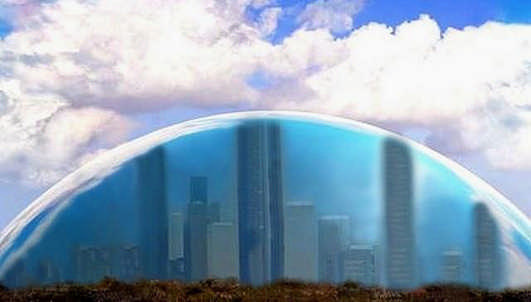
image from S. P. Alekseev
References
1. Marcus Vitruvius Pollio, de Architectura in English translation by Joseph Gwilt, 1826.
2. L. G. Dmitriev and A. V. Kasilov: Cable Roofs, Kiev, 1974.
3. A. N. Zverev: Large-span roof structures for public and industrial buildings, SPb GASU, 1998.
4. N. M. Kirsanov: Suspended and cable structures, Stroiizdat, 1981.
5. V. A. Smirnov: Cable-stayed bridges suspended over large spans), Vysshaya Shkola, 1970.
6. http://ais.by/story/3512 – Cable roof over multifunctional athletic arena (Architecture and Construction) V. 11, 2009, Minsk.
7. Eurasian patent No. 016435, Protection Structure Having a large-Span Translucent Roof.
8. http://blog.dp.ru/post/3969/ – Large-span translucent protection structures: Way to a comfortable and secure living (Delovoi Peterburg (Business Petersburg), SPb, 2012.
9. http://blog.dp.ru/post/4003/ – Atria as the basis for urban architecture of the future for Russia. Atrium structures and buildings (Business Petersburg website), SPb, 2012.
10. http://www.breeam.com/ – BRE Environmental Assessment Method (BREEAM).
11. http://www.un.org/ru/development/sustainable/csd.shtml – UN and Sustainable Development.
12. http://www.leed.net/ – Leadership and Environmental Design certification program website.
13. Proceedings of Agenda 21: UN Conference on Environment and Development (UNCED), Rio de Janeiro, 1992.
Project Summary
Purpose
Construction of translucent structures with the purpose of creating comfortable and safe internal areas of large coverage, providing long-term protection of people, buildings and adjacent territories from unfavorable effects of the environment.
1. Product/Service (Expected Profits).
Sale and/or lease of large-span translucent roof-covered commercial property of various functionality.
2. Advantages over Similar Products/Services and Competition
Large-span translucent roof-covered eco-buildings can be of various shape and size; they are considerably less expensive in construction and more cost and energy efficient in operation, at the same time, being more durable and having simpler design and layout features. There are many other advantages as well. No competition known as of today: the closest prior art developments are inferior in terms of all basic parameters.
3. Realization Stage (Commercial Capabilities)
The project is ready for realization. The principle technologies, equipment, materials and skilled personnel are available in the construction market; however, some additional calculations and design modifications are required to produce certain units and parts; and certain innovative systems and materials also need to be introduced.
4. Estimated economic indicators including investments required, payback period and profits
The project can be a success commercially, provided that it has a well-developed action plan and, especially, a wisely planned marketing strategy. With marketing activities adequately and professionally organized, the project can reach a break-even (or make a profit) before the construction starts.
Project parameters are crucial for the success, especially the project location and scope. For instance, a reasonably sized, 200-m high, glazed pyramid structure will cover an area of 9.0 ha and at least 320 thousand square meters of commercial premises in multistoried buildings. Estimated construction budget is 400 450 million US dollars; lead time estimate is 4 5 years.
5. Intellectual property protection:
Eurasian patent No. 016435 Protection Structure Having a large-Span Translucent Roof http://www.eapatis.com/ruSearch/ms.exeData/EAPO/eapo2012/PDF/016435.pdf; PCT expanded patent application filed; a number of know-how developed.
6. Supplementary Information:
http://blog.dp.ru/post/4699/, http://lstps.3dn.ru/, [email protected]
Translated by N. Pomortseva 2013
‘Eco Sustainable Architecture of the Future. Large-Span Translucent Buildings and Structures’ Article from Sergey P. Alekseev Structural Engineer
Architecture Articles
Design: ESPACE VITAL architecture
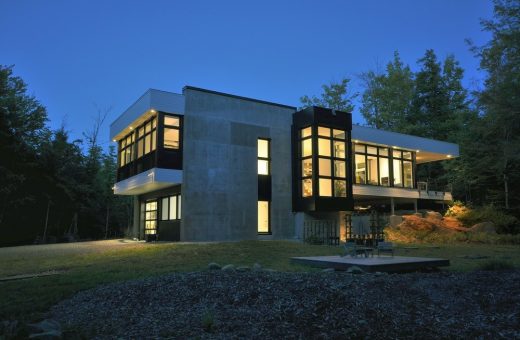
photo : Stéphane Lemire
Shelter on a Rock in Racine, Québec
Comments / photos for the Large Span Translucent Building Design Article page welcome.

